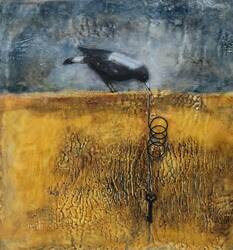Encaustic Workshop - Painting with Wax with Sherilyn Hawley
Provided by: Woolgoolga Art Group
Daily, 2 times
The event you have selected has been completed and is no longer available!
ENCAUSTIC FACT SHEET
1. Encaustic is an ancient art form dating back to the 5th century
2. Beeswax is extremely archival, it is what we add to the beeswax that could effect it.
3. You can paint, collage, sculpt, stencil and embed in encaustic. It is used for mixed media, you can paint anything including portraits. You can work on a smooth encaustic surface or a textured service.
4. Encaustic medium is made from Beeswax and either Damar or Castor wax in an 8:1 ratio
5. Encaustic medium is easily available and can also be handmade. The best way to colour your wax and make blocks from it is to use powdered pigments, you can also use a small amount of oil paint, however powdered pigments are much better as they do not have the additives that oil paint has (linseed oil)
6. You need to work in a well ventilated area. Outside is desirable. If working inside you need open windows and a fan to blow any fumes away.
7. Wax melts at 62 deg centigrade, it should not be left in a hot car. Like any artwork it should not sit in direct sunlight.
8. Wax should not be heated over 200c if it smokes it is too hot..a low heat is desirable, slow and steady melting is best.
9. Encaustic medium will shed and bloom for up to 1 year. Buffing your painting will bring back the lovely satiny shine.
10. Encaustic can be painted on any solid and absorbent surface. Timber boards, cradle boards, masonite, MDF, repurposed timber. You can add wax and colour to sculptures.
11. You cannot use the usual Gesso to prime the boards, in fact you don’t need to prime if you are adding full layers of wax. You can buy Gesso especially for encaustic but if I were to use Gesso, I would make my own from Rabbit skin glue and Calcium Carbonate, I question the Gesso available as it still has some acrylic added to it.
12. You can colour your painting by adding colours after you have laid base layers on encaustic on the substrate. You can use powdered pigment, pan pastels, scraped soft pastels, oil sticks, or oil paint. If using oil paint you should not add anymore than 25% oil to the encaustic.
You can add marks with alcohol ink or oil sticks. YOU CANNOT use Acrylic paint and water and wax won’t mix.
13. Encaustic must be fused (with either a heat gun or a blow torch), after each layer that is added. Every time you add colour it must be fused.
14. You don’t need expensive brushes for encaustic, as long as they are natural bristle brushes. You need a variety of brushes if you are going to use Coloured Encaustic medium. ( a seperate brush for each colour)
Materials needed if you wish to start encaustic painting
Medium. Bought or made. Langridge is an Australian company that supply the medium and more
Old fry pan or flat griddle.
Bristle brushes
Various colour options
Substrate
Blow torch or craft heat gun (if working on a large board use a blow torch)
Clay tools to incise or carve wax.
Vegetable oil for removing excess colour.
Soft rags for polishing. (Nothing that has loose lint) Nylon or microfibre is good
About
ENCAUSTIC WORKSHOP – PAINTING WITH WAX
Sherilyn Hawley
May 2021
Saturday 29th May (half day) 1pm - 5pm
Sunday 30th May 9am - 5pm (full day)
Fee $150 - Maximum class number 8
Day 1 – Half day
The following will be covered -
Safety using hot wax
Basic laying down of wax to substrate.
How to mix /make encaustic colours
What mediums can be used with encaustic
Day 2 - Full day
Painting with encaustic
Making textures
Using stencils
Incising wax
Mark making with ink
Supplies provided
Encaustic medium
Encaustic medium – colours
Pastels/ ink/ pigment/ oil colour
Substrate – Up to 2 boards provided 30 x 30cm and 20 x 40cm
What you will need
An old frypan or skillet
A variety of natural bristle brushes these can be Monte Marte or chip brushes from a hardware store, NOT NYLON (very important)
Wet ones to keep hands clean
Butane lighter/gun
A heat gun, embossing heat gun or a blow torch (this is preferable) BUNNINGS - Tradeflame 220g Handy Blow Torch Kit With Butane Gas
I/N: 5910258
$29.98 - cost of Bunnings heat gun
Optonal equipment
A smock
Sketchbook/notebook, pencil or pen for note taking Pastels, ink, oil paint, oil sZcks,
Any clay tools you may have
Any stencils you may like
Latex gloves as you will be handling and rubbing in paint with your hands.


